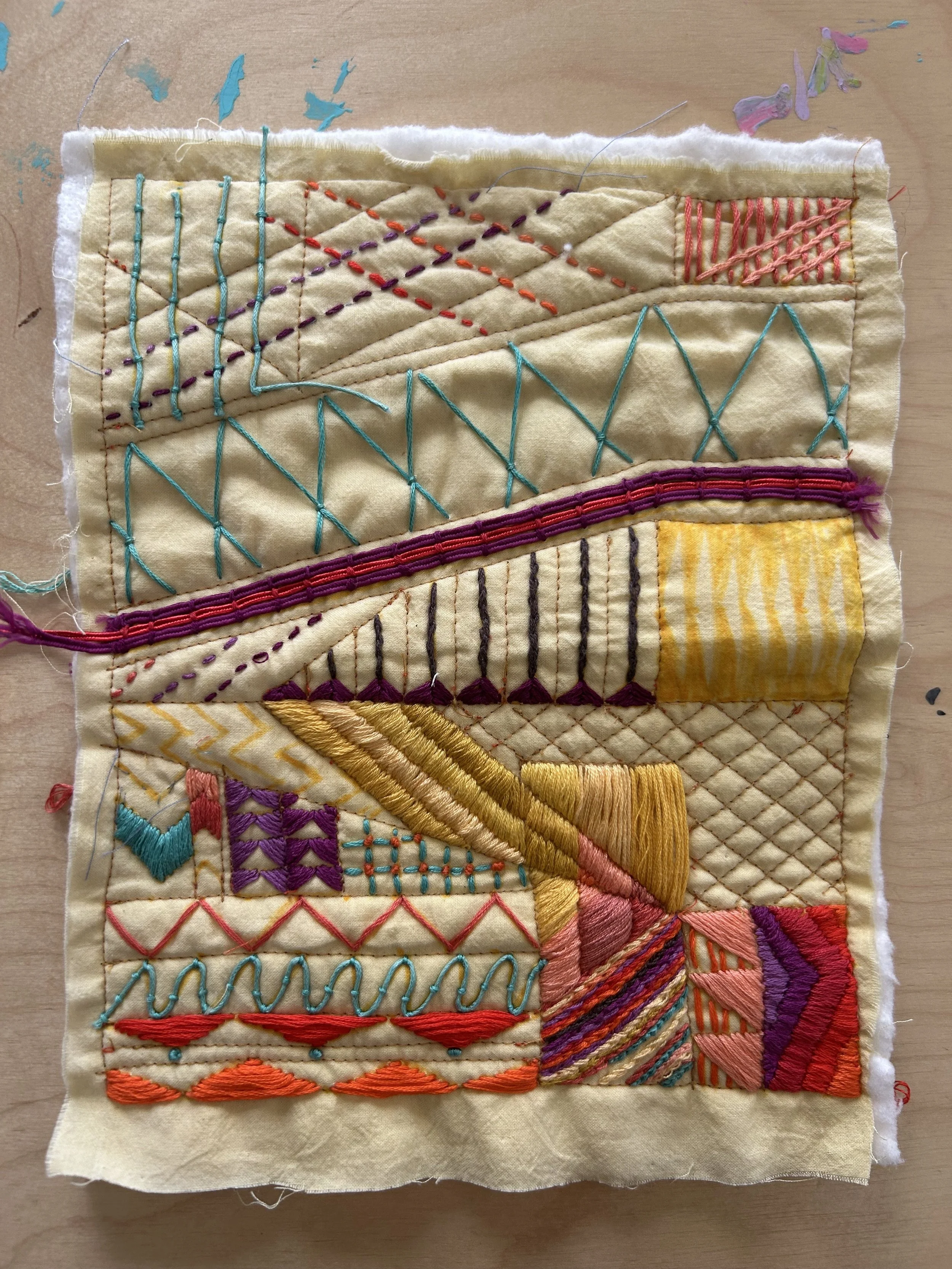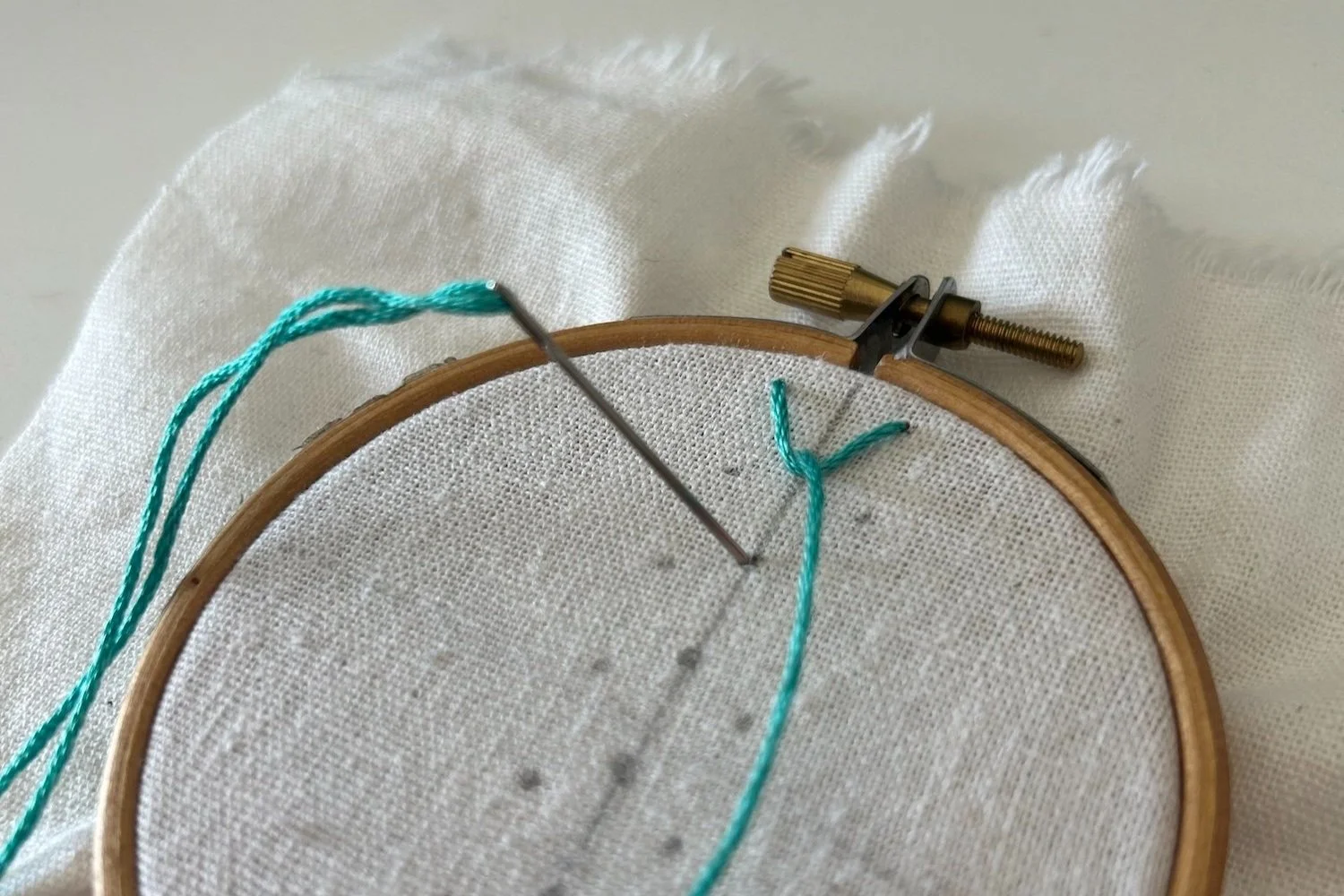Backstitch
Backstitch
A basic stitch used to outline shapes, lines, and fills.
What is a Backstitch?
Backstitch embroidery is one of the most essential techniques in the world of needlework. While many stitches may come and go depending on trends and artistic styles, the backstitch remains a cornerstone of both functional and decorative embroidery. Its precision and strength make it invaluable for outlining, lettering, and creating intricate designs. In this comprehensive guide, we'll explore everything you need to know about the backstitch, from its history and applications to mastering the technique and using it in creative embroidery projects.
How to Create a Backstitch
Materials You Will Need
Embroidery hoop for maintaining tension
Embroidery thread (floss) in your chosen color
Embroidery needle
Scissors
Steps to Make a Backstitch
Step 1 Prepare your materials: Start by securing your fabric in an embroidery hoop to keep it taut and wrinkle-free. Thread your embroidery needle with about 18-24 inches of floss and tie a small knot at the end of the thread to anchor it.
Step 2 Bring the needle up through the fabric: From the underside of the fabric, push the needle up through the starting point of your line, pulling it all the way through until the knot is snug against the fabric.
Step 3 Take your first stitch forward: Move the needle about 1/8 to 1/4 inch forward (depending on how large you want your stitches to be) and push the needle back down through the fabric.
Step 4 Bring the needle up for the next stitch: Move your needle forward another 1/8 to 1/4 inch (equal to your first stitch) and bring it up through the fabric again.
Step 5 Stitch backward: Now comes the "back" in backstitch—insert the needle into the end of your previous stitch and pull the thread through. This creates a continuous line with no gaps.
Step 6 Repeat: Continue bringing the needle up, moving it forward, and then stitching back into the end of the last stitch until your line is complete.
Step 7 Finish off: When you reach the end of your stitching line, bring the needle to the back of the fabric, knot the thread, and trim any excess.








Tips & Tricks
Keep your stitches consistent: One of the most critical aspects of a good backstitch is maintaining consistency in your stitch length. Use a fabric marker or lightly mark your fabric with dots to ensure your stitches remain even.
Use an embroidery hoop: Keeping the fabric taut will make it easier to create neat, even stitches without distorting the fabric.
Pull the thread evenly: Avoid pulling the thread too tightly, as this can cause the fabric to pucker. Instead, aim for even tension throughout your stitching.
Work with shorter lengths of thread: Long lengths of thread are more likely to tangle and knot, which can make your stitching uneven. Work with a manageable length of floss—around 18-24 inches is ideal.
Practice on scrap fabric: If you’re new to backstitching or trying out a new pattern, it’s a good idea to practice on a piece of scrap fabric first.
Common Problems with Backstitch (and How to Fix Them)
fchgfhgchghg
Problem 1:
History of the Backstitch
jhgjhgjhgiugiuiuhiuh
Ways To Use a Backstitch
The backstitch’s versatility makes it suitable for a wide range of embroidery projects. Whether you're working on a functional piece like clothing or a decorative design, the backstitch can serve multiple purposes. Here are some of the most common applications for the backstitch in embroidery:
Outlining Shapes and Designs
One of the most popular uses of the backstitch is outlining. Backstitch creates clean, solid lines, making it perfect for defining the edges of shapes, motifs, and patterns in your embroidery. Outlining your designs with a backstitch can make them stand out and add clarity to intricate details.
For instance, in floral embroidery, the backstitch can outline the petals and leaves, giving the design more definition. You can also use the backstitch to highlight features in a portrait or add sharp lines in geometric patterns.
Lettering and Monograms
The backstitch is an excellent stitch for embroidering text, whether you’re adding a short quote, initials, or a full monogram to a piece. Its neat, unbroken line creates clear, readable letters, even on a small scale. You can use the backstitch to create cursive or block letters, depending on the style you're going for.
Monograms made with backstitches are a popular way to personalize items such as towels, napkins, bags, and clothing. Because the stitch is durable, it holds up well on items that are frequently washed or used.
Repairing and Reinforcing Seams
In addition to its decorative uses, the backstitch is also highly functional. It’s one of the strongest stitches in hand sewing, making it ideal for repairing or reinforcing seams in garments, quilts, or home textiles. When used for hand-sewn seams, the backstitch mimics the durability of machine stitching, ensuring that the seam remains intact even with regular wear and tear.
Embroidery Detail Work
The backstitch is excellent for adding fine details to an embroidery project. Whether you're working on a large piece or a small, intricate design, the backstitch allows you to add precision. For example, in animal embroidery, backstitches can be used to define fur textures, add whiskers, or create lifelike details in the eyes.
Cross-Stitching and Samplers
While the backstitch is often used on its own, it can also complement other embroidery techniques, such as cross-stitching. In cross-stitch, backstitches are commonly used to outline the main design, adding a final touch of detail and sharpness. Many cross-stitch patterns include backstitch instructions to enhance the visual impact of the finished piece.
Creating Borders
Backstitching can also be used to create decorative borders around a piece of embroidery. By stitching a continuous line around the edge of your design, you can create a finished, polished look. For added creativity, you can combine backstitch borders with other decorative elements like French knots or satin stitch accents.
Level Up Your Backstitch With Variations
While the basic backstitch is an invaluable tool, there are a few variations that can add extra texture and visual interest to your work. Here are some variations of the backstitch that you might want to try.
Whipped Backstitch
The whipped backstitch involves working a second thread through the backstitches, “whipping” it around each stitch. This creates a slightly raised, braided effect that can add texture and depth to your embroidery. Whipped backstitches are often used for decorative borders or to add emphasis to certain parts of a design.
Stem Stitch
The stem stitch is closely related to the backstitch but creates a more flowing, rope-like effect. Instead of working directly back into the last stitch, you bring the needle up slightly to one side of the previous stitch. This stitch is often used for creating curving lines, such as vines or stems in floral embroidery.
Double Backstitch (Holbein Stitch)
In the double backstitch, you first work a regular backstitch line, then go over the same line again, filling in any gaps between the stitches. This creates a very solid, thick line and is commonly used in
Backstitch in Modern Embroidery
The backstitch has been used for centuries in various cultures worldwide. It can be traced back to ancient textile practices, appearing in early forms of embroidery in civilizations such as ancient Egypt, Greece, and China. Throughout history, the backstitch was employed both for practical purposes—such as mending clothes and reinforcing seams—and as a decorative stitch in elaborate embroidered garments, tapestries, and textiles.
One of the most well-known historical examples of backstitch embroidery is the Bayeux Tapestry, an embroidered cloth that dates back to the 11th century. The tapestry, which depicts the events leading up to the Norman conquest of England, features extensive use of backstitching to outline figures and scenes, showcasing the stitch’s enduring value in storytelling through needlework.
Today, the backstitch is a mainstay in both traditional and contemporary embroidery. Its adaptability means it can be found in delicate, hand-embroidered wedding gowns as well as bold, modern designs on clothing and home decor.












